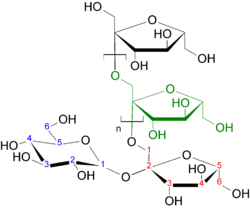프룩탄
Fructan
프룩탄은 과당 분자의 중합체이다.짧은 사슬 길이를 가진 프룩탄은 프룩토올리고당으로 알려져 있다.프룩탄은 아가베, 아티초크, 아스파라거스, 부추, 마늘, 양파, 야콘, 지카마, 보리, 밀과 같은 단조류와 쌍떡잎을 포함한[1] 12% 이상의 혈관 배지에서 발견될 수 있다.
프룩탄은 또한 말이나 다른 방목 동물(Equidae)에게 식이학적 영향을 미치는 풀에도 나타난다.
종류들
프룩탄은 일반적으로 환원 말단이 될 수 있는 수크로스 단위(즉 포도당 이당류)와 함께 과당 잔기로 구성된다.과당 잔류물의 결합 위치는 프룩탄의 종류를 결정한다.프룩탄에는 [2]5가지 종류가 있다.
연결은 일반적으로 두 가지 1차 하이드록실(OH-1 또는 OH-6) 중 하나에서 발생하며, 단순 프룩탄에는 두 가지 기본 유형이 있습니다.
세 번째 유형의 프룩탄인 그라민형은 [2]β-2,1-고리와 [3]β-2,6-고리를 모두 포함한다.
두 종류의 프룩탄은 더 복잡하다: 그들은 분자의 양쪽에서 신장이 일어나는 6G-케스토트리오스 골격에서 형성된다.다시 두 가지 유형이 식별됩니다.
기능들
프룩탄은 많은 종의 풀 줄기에 있는 중요한 저장 다당류이며 어느 정도의 [4][5]내한성을 부여합니다.눈에 띄는 예외는 프룩탄을 [6]합성할 수 없는 쌀이다.
보리에서 프룩탄은 세포포에 축적되어 광합성을 촉진하기 위해 세포 내에서 탄소 흡수원으로 작용한다.프룩탄 매장량은 곡물 충전 중에는 생식 조직으로, 성장기에는 [citation needed]식물 조직으로 운반된다.
치커리 이눌린형 프룩탄은 주로 식재료인 프룩탄의 공업생산 원료로 사용된다.식품 산업에서의 사용은 프룩탄의 영양 및 기술적 특성에 기초하고 있습니다.[7][8]
다양한 식품의 프룩탄 함량
| 아가베 | 7 ~ 25 %[8] |
| 예루살렘 아티초크 | 16.0~20.0%[9] |
| 글로브 아티초크 | 2.0~6.[9]8% |
| 아스파라거스 | 1.4~4.[9]1% |
| 보리알(아기) | 22 %[10] |
| 마늘 | 17.4%[11] |
| 양파 | 1.1~10.[9]1% |
| 호밀(브란) | 7 %[12] |
| 호밀(곡물) | 4.6~6.[12]6% |
| 밀빵(흰색) | 0.7~2.[9]8% |
| 밀가루 | 1~4 %[10] |
| 밀 파스타 | 1~4 %[9] |
「 」를 참조해 주세요.
- 식이섬유 – 식물 유래 식품 중 완전히 소화되지 않는 부분
- 프리바이오틱(영양) – 미생물의 성장을 유도하는 영양화학물질
메모들
- ^ Hendry, George (1987). "The Ecological Significance of Fructan in a Contemporary Flora". New Phytologist. 106 (s1): 201–216. doi:10.1111/j.1469-8137.1987.tb04690.x. ISSN 1469-8137.
- ^ a b c d Chibbar, R. N.; Jaiswal, S.; Gangola, M.; Båga, M. (2016). "Carbohydrate Metabolism". Reference Module in Food Science. doi:10.1016/B978-0-08-100596-5.00089-5. ISBN 9780081005965.
Fructans, on the basis of glycosidic linkage, are categorized into five groups: (a) inulin having β(2 → 1) linkage, (b) levan/phlein having β(2 → 6) linkage, (c) graminin (having inulin or levan backbone with ≥ 1 short branch), (d) inulin neoseries (like inulin but one glucose unit between two fructose moieties), and (e) levan neoseries (like levan but one glucose unit between two fructose moieties) (Figure 1).
- ^ Van den Ende, Wim (2013). "Multifunctional fructans and raffinose family oligosaccharides". Frontiers in Plant Science. 4: 247. doi:10.3389/fpls.2013.00247. PMC 3713406. PMID 23882273.
- ^ Pollock, C. J. (1986). "Tansley Review No. 5 Fructans and the Metabolism of Sucrose in Vascular Plants". New Phytologist. 104 (1): 1–24. doi:10.1111/j.1469-8137.1986.tb00629.x. PMID 33873815.
- ^ Pollock, C. J.; Cairns, A. J. (1991). "Fructan Metabolism in Grasses and Cereals". Annual Review of Plant Physiology and Plant Molecular Biology. 42: 77–101. doi:10.1146/annurev.pp.42.060191.000453.
- ^ Kawakami, A.; Sato, Y.; Yoshida, M. (2008). "Genetic engineering of rice capable of synthesizing fructans and enhancing chilling tolerance". Journal of Experimental Botany. 59 (4): 793–802. doi:10.1093/jxb/erm367. PMID 18319240.
- ^ Meyer, D.; Bayarri, S.; Tárrega, A.; Costell, E. (2011-12-01). "Inulin as texture modifier in dairy products". Food Hydrocolloids. 25 years of Advances in Food Hydrocolloid Research. 25 (8): 1881–1890. doi:10.1016/j.foodhyd.2011.04.012. ISSN 0268-005X.
- ^ a b Tungland, Bryan (1 June 2018), Tungland, Bryan (ed.), "Chapter 8 - Nondigestible Fructans as Prebiotics", Human Microbiota in Health and Disease, Academic Press, pp. 349–379, doi:10.1016/b978-0-12-814649-1.00008-9, ISBN 9780128146491
- ^ a b c d e f Shepherd, Susan J. (2006). "Fructose Malabsorption and Symptoms of Irritable Bowel Syndrome: Guidelines for Effective Dietary Management" (PDF). J Am Diet Assoc. 106 (10): 1631–1639. doi:10.1016/j.jada.2006.07.010. PMID 17000196.
- ^ a b Slavin, Joanne L. (2000). "Mechanisms for the Impact of Whole Grain Foods on Cancer Risk". Journal of the American College of Nutrition. 19 (90003): 300S–307S. doi:10.1080/07315724.2000.10718964. PMID 10875601. S2CID 43665952.
- ^ Muir, J.G.; et al. (2007). "Fructan and Free Fructose Content of Common Australian Vegetables and Fruit". Journal of Agricultural and Food Chemistry. 55 (16): 6619–6627. doi:10.1021/jf070623x. PMID 17625872.
- ^ a b 카르피넨, 경.호밀기울의 식이섬유 성분 및 체외 발효.Espoo 2003.VTT 퍼블리케이션 500. 96 p. + 앱.52 p. [1 ]
레퍼런스
- 설탕 – 수크로스의 화학적, 생물학적 및 영양학적 측면.존 유드킨, 잭 에델만, 레슬리 허프(1971년, 1973년).버터워스 그룹이요ISBN 0-408-70172-2

